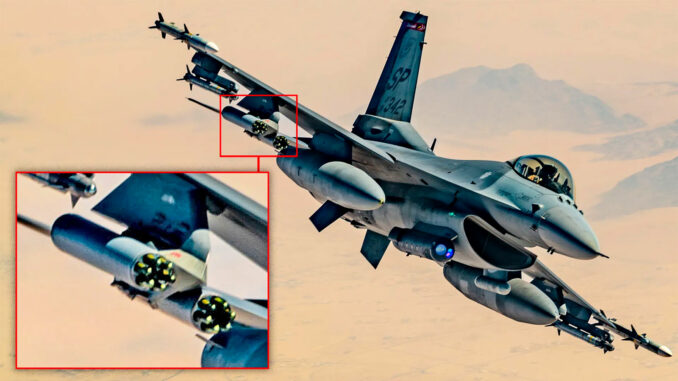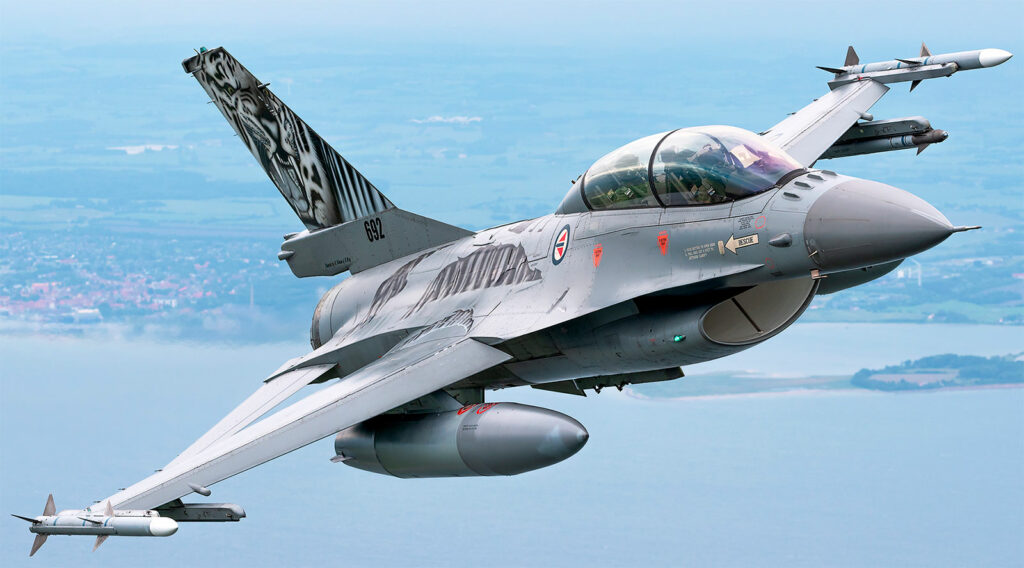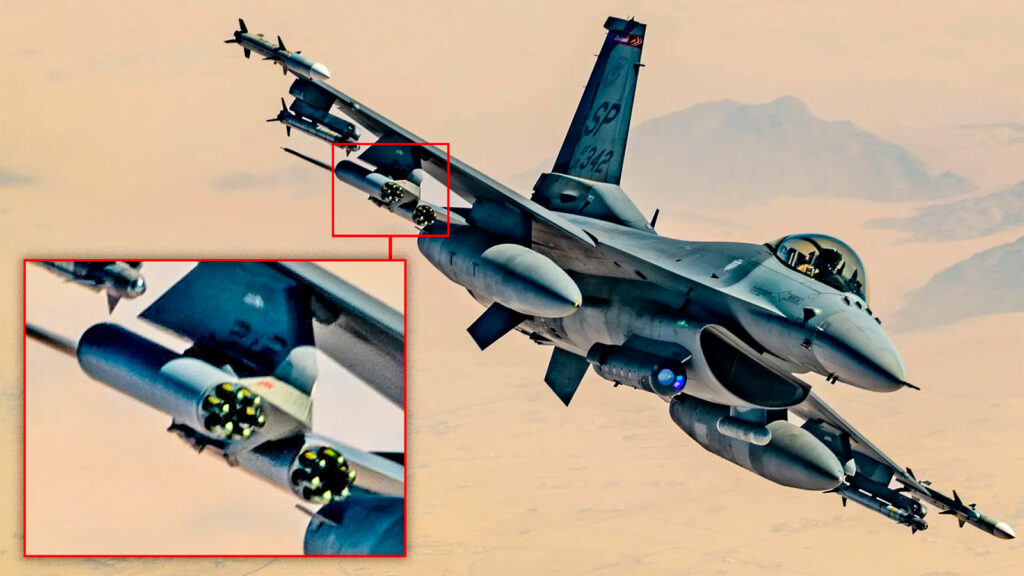
US Air Force F-16C Viper aircraft deployed in the Middle East are now equipped with 70 mm laser-guided rockets, increasing their ability to cost-effectively neutralize enemy drones. This adaptation enables pilots to engage aerial targets with greater precision, while reducing costs compared with traditional missiles. This development reflects the ongoing innovation in air defense strategies in the face of asymmetric threats.
Increasing F-16 payload with laser-guided rockets
Recent images show US Air Force F-16C Viper aircraft on patrol in the Middle East, equipped with two 70 mm laser-guided rocket pods, mounted on a single pylon under the right wing using a triple ejector (TER). This configuration doubles the engagement capacity of previous single-pod configurations. Each pod holds seven rockets, bringing the total to fourteen ready-to-use rockets. This significant increase in payload gives pilots more options for engaging multiple targets without the need for immediate rearming. This configuration is particularly advantageous in environments where threats are many and varied, offering enhanced operational flexibility.

APKWS II rockets for air-to-air engagement
The 70 mm rockets used are equipped with the Advanced Precision Kill Weapon System II (APKWS II) laser guidance system, originally designed for air-to-ground missions. However, the US Air Force has demonstrated their effectiveness in air-to-air roles, notably for shooting down hostile drones. This adaptation offers a less expensive alternative to traditional air-to-air missiles such as the AIM-9 Sidewinder or the AIM-120 AMRAAM. The unit cost of an APKWS II rocket is estimated at between $15,000 and $20,000 (approx. 13,500 to 18,000 euros), while an AIM-9X Sidewinder Block II missile costs almost $420,000 (approx. 378,000 euros). This cost difference means that laser-guided rockets can be used more extensively without compromising operational efficiency. What’s more, the modularity of the APKWS II system means it can be integrated on a variety of aircraft types without major modifications, facilitating rapid deployment to meet tactical requirements.
Victory markings on UAVs and mixed weapons
Some of the images show F-16Cs sporting victory markings on enemy drones, underlining the success of these missions. The markings, located under the cockpit, depict silhouettes of downed drones, attesting to the effectiveness of APKWS II rockets in real-world engagements. The aircraft are also equipped with a mix of AIM-120 AMRAAM and AIM-9 Sidewinder air-to-air missiles, in addition to laser-guided rockets. This combination of weapons offers increased versatility, enabling pilots to choose the most appropriate weapon depending on the nature of the threat. For example, AIM-120 AMRAAM missiles are effective against longer-range targets, while APKWS II rockets offer a cost-effective solution for short-range targets such as drones. This flexibility in weaponry enables a tailored response to a variety of tactical scenarios, optimizing mission effectiveness.

Strategic consequences of using laser-guided rockets
The adoption of laser-guided rockets for air-to-air missions offers several strategic advantages. Firstly, it significantly reduces costs per engagement, freeing up resources for other operational needs. Secondly, the increased ammunition-carrying capacity provided by multiple rocket pods improves the F-16’s ability to handle saturation attacks, where numerous drones or missiles are launched simultaneously. This enhanced capability is crucial in environments where asymmetric threats are common. In addition, the use of laser-guided rockets reduces reliance on more expensive missiles, enabling a more strategic allocation of resources. Finally, this approach offers tactical flexibility, enabling air forces to adapt rapidly to changing threats without requiring major modifications to existing platforms. This adaptability is essential for maintaining an operational edge in dynamic and unpredictable theaters of operation.
Future prospects for laser-guided rockets in air combat
The successful integration of APKWS II rockets into air-to-air missions could pave the way for wider adoption of this technology on other airborne platforms. Aircraft such as the A-10 Warthog and the F/A-18 Hornet, as well as helicopters like the AH-64 Apache, could benefit from this capability, increasing their effectiveness against low-cost air threats. In addition, future developments could include improved guidance systems to increase range and accuracy, as well as the integration of new warheads to diversify the types of targets that can be engaged. For example, the addition of proximity fuzes could improve effectiveness against swarms of drones. These potential improvements would enhance the versatility and effectiveness of air forces in the face of constantly evolving threats. In addition, international collaboration in the development and sharing of these technologies could accelerate their adoption and refinement, thus contributing to enhanced collective security.
War Wings Daily is an independant magazine.